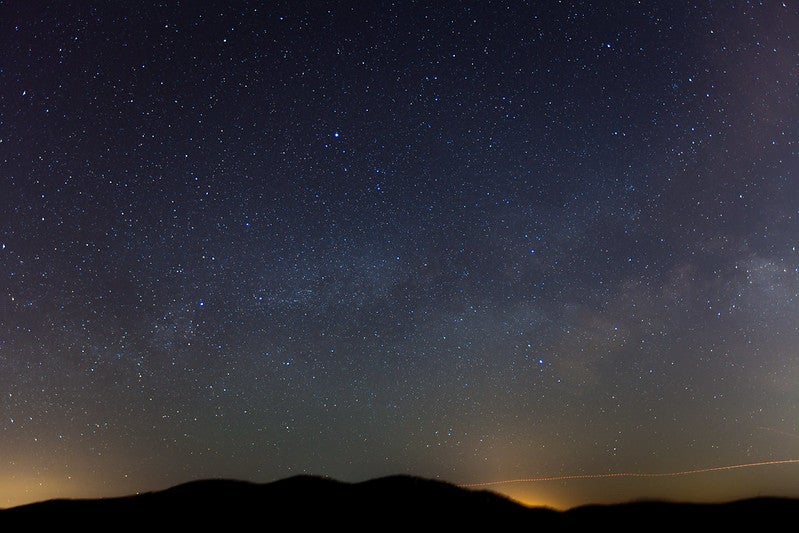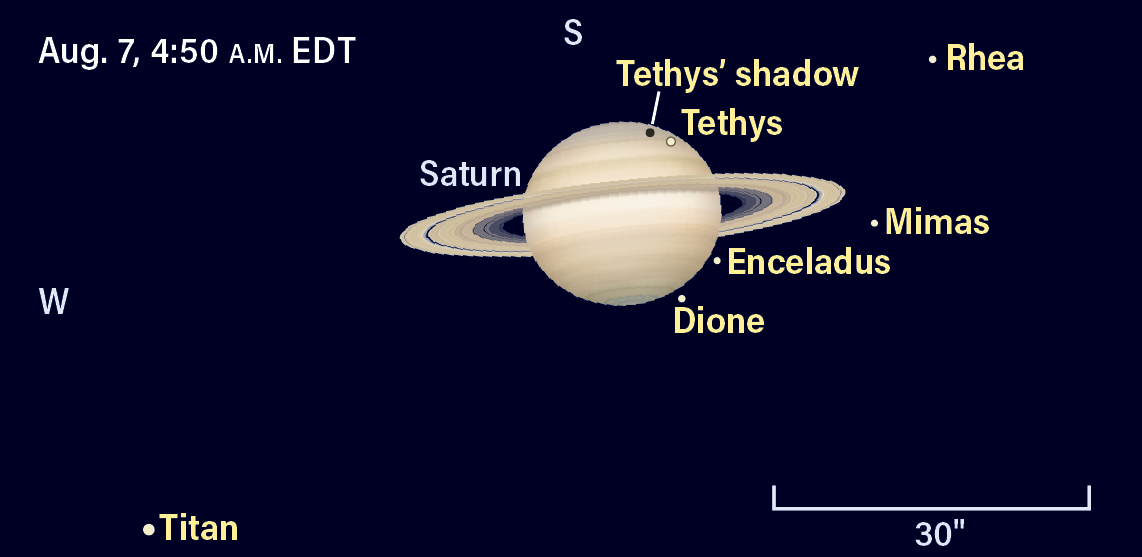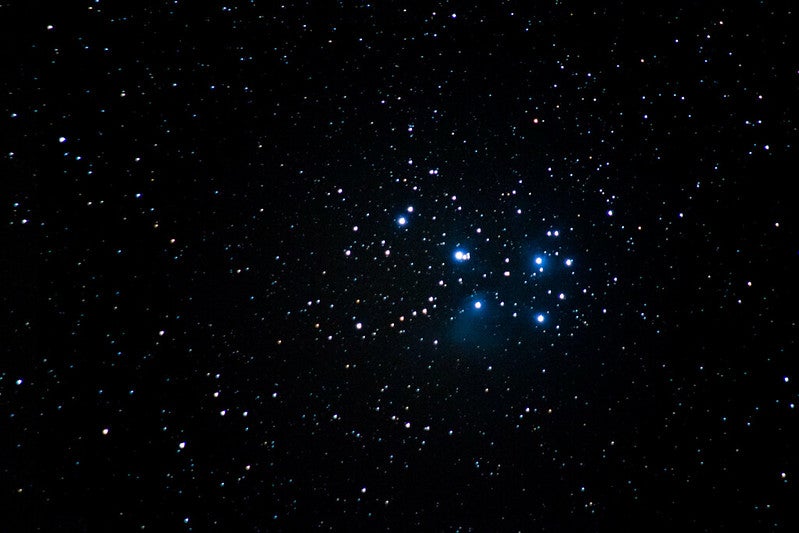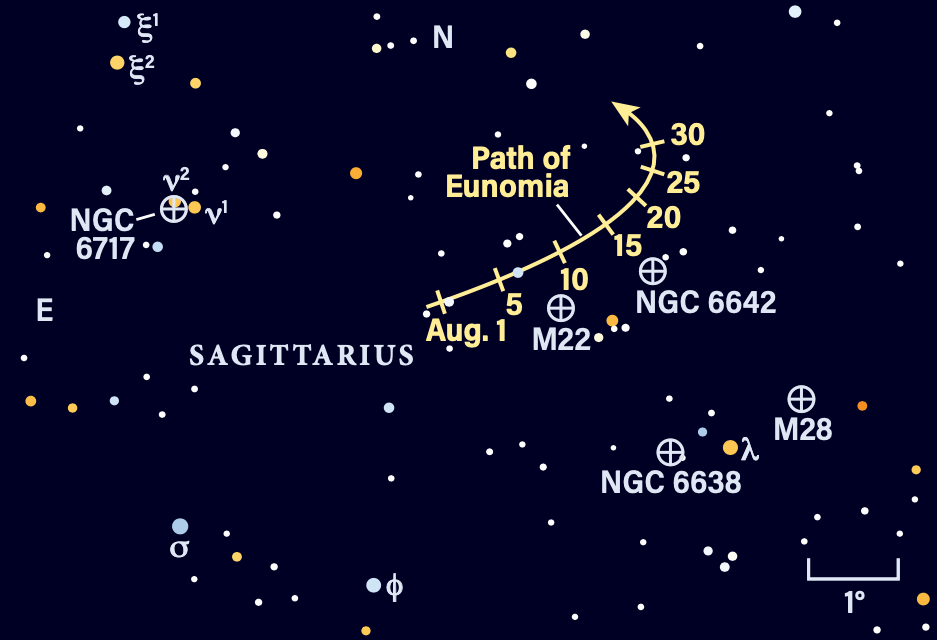
Friday, August 4
The Moon passes 1.5° south of Neptune at 6 P.M. EDT, though the pair doesn’t rise until just after 10 P.M. local daylight time.
Neptune is distant and therefore faint, glowing at roughly 8th magnitude. That renders it invisible to the naked eye, requiring binoculars or a telescope to spot. However, with the Moon nearby, let’s save Neptune for later in the week and look southwest instead, toward the large circular constellation Ophiuchus.
This constellation is 11th largest out of the 88. But it’s hard to find both because it’s so big and also because its stars are relatively faint. The brightest is 2nd-magnitude Rasalhague, which sits in the northern part of the constellation near fainter, third-magnitude Rasalgethi in Hercules.
Ophiuchus’ size is a boon, though, when it comes to the number of deep-sky objects it contains, including seven Messier objects, all globular clusters. One of these is 6th-magnitude M12, located about 19° below Rasalhague as the constellation is sinking this evening and just over 5.5° southeast of 4th-magnitude Lambda (λ) Ophiuchi. Most go-to scopes should have Messier’s list in their computerized catalog, allowing you to quickly center right on this object to enjoy it. M12 stretches nearly 15′ across, or half the width of a Full Moon, and not considered a highly concentrated globular. Take a look through a telescope or binoculars and see what you think.
If you want another cluster for immediate comparison, you can easily skip over to its near neighbor, M10, a slightly smaller globular that lies just 3.3° southeast of M12. It, too, is a great binocular or telescopic target, with a center that is more tightly packed than its counterpart.
Sunrise: 6:01 A.M.
Sunset: 8:10 P.M.
Moonrise: 10:18 P.M.
Moonset: 9:23 A.M.
Moon Phase: Waning gibbous (87%)
*Times for sunrise, sunset, moonrise, and moonset are given in local time from 40° N 90° W. The Moon’s illumination is given at 12 P.M. local time from the same location.
Saturday, August 5
The Summer Triangle still flies high overhead after full darkness, its three bright stars — Deneb in Cygnus, Altair in Aquila, and Vega in Lyra — spanning the stunning Milky Way. But there’s more to this asterism than just its brightest luminaries. Today, we’re going to explore three variable stars in or near the Triangle, one in each of its anchoring constellations.
Let’s start in Aquila. Our first star lies outside the Triangle, about 11° due west of Altair. This is 5th-magnitude R Aquilae, a red giant with a 270-day period. When it is brightest, it’s visible to the naked eye as a reddish star. But at its faintest, it requires binoculars or a small scope to find. Which is it tonight?
From here, let’s move north into Lyra to observe Sheliak, also cataloged as Beta (β) Lyrae. Just at the edge of the Summer Triangle’s bounds, Sheliak sits 6° south-southeast of Vega. Averaging a magnitude of 3.5, Sheliak dims by about two-thirds its usual brightness over a little under two weeks. This star, like the more famous Algol in Perseus, is an eclipsing binary with a companion that passes in front of and behind it, causing the brightness changes we see. The best way to watch this change is to compare Sheliak to its nearby neighbors over the course of two weeks.
Our last Summer Triangle star is in Cygnus. Chi (χ) Cygni lies closer to the Swan’s head than its tail, sitting about 6.5° northeast of the stunning double star Albireo. This Mira-type variable physically changes size, which affects its temperature and thus brightness in a regular pattern. Its period is longer than a year — some 400 days — and it cycles between magnitudes 3 or 4 and 14! Like R Aquilae, it is sometimes visible to the naked eye and other times requires optics to identify.
Sunrise: 6:02 A.M.
Sunset: 8:09 P.M.
Moonrise: 10:43 P.M.
Moonset: 10:37 A.M.
Moon Phase: Waning gibbous (79%)
Sunday, August 6
Now that the Moon is rising later, let’s try for Neptune in the dark window between when the ice giant rises and our satellite appears. Around 10:45 P.M. local daylight time, Neptune is nearly 10° high and the Moon is has yet to rise. The planet sits just above the eastern horizon, below the Circlet of Pisces asterism.
Remember, Neptune is magnitude 7.7 and requires binoculars or a small telescope to bring into view. You’ll find it forming a roughly equilateral triangle with 24 and 20 Piscium, both 6th-magnitude stars in far southwestern Pisces. Neptune sits on the north side of these stars, about 1° northwest of 24 Psc. Don’t confuse it with a background star of similar brightness just to the ice giant’s southeast.
While you’re in the area, swing up slightly to examine the star TX Piscium (also cataloged as 19 Psc), a 5th-magnitude sun 2° northeast of Lambda Psc. TX is a red giant with a deep crimson color; it is classified as a carbon star and appears particularly red because the carbon in its atmosphere scatters away bluer wavelengths. This star — like many older suns — is also variable, though its light changes by only a fraction of a magnitude.
Sunrise: 6:03 A.M.
Sunset: 8:08 P.M.
Moonrise: 11:08 P.M.
Moonset: 11:50 A.M.
Moon Phase: Waning gibbous (69%)

Monday, August 7
Saturn is approaching opposition later this month, presenting a perfect target for skywatchers during both the post-twilight and pre-dawn hours. The planet sits in the constellation Aquarius, where it now spans 19″. Its magnificent rings stretch some 43″ across.
Early this morning, giant planet’s moons are putting on a show. Thanks to the system’s orientation relative to Earth, some moons currently undergo transits of and occultations by Saturn’s disk. There’s a slew of events that kicks off around 3:15 A.M. EDT, when 10th-magnitude Dione skims the planet’s north pole. The moon spends about an hour and a half crossing the pole; around the time it’s done, at 4:41 A.M. EDT, 12th-magnitude Enceladus reappears from behind the planet’s northeastern limb. The faint moon’s light may be hard to pick up amid the brighter glare of the planet and rings; only larger telescopes will likely be successful.
At the same time, though, there’s still more going on. Tenth-magnitude Tethys has been approaching the planet’s southeastern limb. Starting around 4:40 A.M. EDT, the moon’s shadow slips onto the cloud tops, followed shortly by the moon (the shadow sits southwest of the moon as it crosses the planet’s southern hemisphere). Follow its progress as morning starts to brighten the sky; take care to put away your telescope well before sunrise from your location, which may be different than the time listed below.
Sunrise: 6:04 A.M.
Sunset: 8:07 P.M.
Moonrise: 11:35 P.M.
Moonset: 1:01 P.M.
Moon Phase: Waning gibbous (58%)
Tuesday, August 8
The Moon passes 3° north of Jupiter at 6 A.M. EDT, shortly before our satellite reaches Last Quarter phase at 6:28 A.M. EDT. The two appear together in the early-morning sky, high in the east in the few hours before sunrise. They’re located in southern Aries, where they’re definitely the brightest things around — Jupiter is now magnitude –2.4, so even the bright light from the Moon, located to the planet’s upper left, shouldn’t completely obscure it.
Through a telescope, Jupiter’s disk is 41″ wide. Its four Galilean moons are visible, with Io (closest) and Ganymede to the east and Europa (closest) and Callisto to the west. Around 3:30 A.M. EDT, the Great Red Spot crosses the middle of the disk; it will be visible before and after this time as well, moving from east to west.
Uranus lies about 8.5° east of the pair. It’s magnitude 5.8, so you will need optical aid to pick it out from the bright background. Over the course of the day, the Moon will slide away from Jupiter until it passes 3° north of Uranus at 9 P.M. EDT. Neither is visible at that time — they won’t rise until roughly midnight, when the Moon has passed by Uranus and has moved into Taurus, inching closer to the Pleiades.
Sunrise: 6:05 A.M.
Sunset: 8:06 P.M.
Moonrise: —
Moonset: 2:11 P.M.
Moon Phase: Waning crescent (47%)

Wednesday, August 9
If you’re up very late on the 8th or very early on the 9th, you can catch the Moon passing under the Pleiades star cluster in Taurus. Also cataloged as M45, this famous group of naked-eye stars has been known since antiquity; although its modern name reflects Greek mythology, many cultures had names and meanings associated with this young cluster of suns. Scattered across nearly 2° of sky, this grouping is an excellent naked-eye or binocular target.
In the hours before dawn, the Moon sits to the Pleiades’ lower right. Beneath them, rising a bit later, is the V-shaped face of Taurus the Bull. The bright red star Aldebaran marks one eye. Following Taurus is Orion the Hunter, sometimes depicted as aiming his large, curved bow upward at the Bull.
For those who prefer to observe in the evening, Mercury reaches greatest eastern elongation (27°) at 10 P.M. EDT. You can find the tiny planet after sunset in the west, though you’ll want to step outside shortly after the Sun disappears — Mercury is just 5° high half an hour after sunset. It’s magnitude 0.4, still relatively bright, though it’s faded significantly since last month. The planet now appears roughly half-lit through a telescope, spanning 8″.
Above and slightly left of Mercury is Mars: The Red Planet is much fainter at magnitude 1.8 and will take longer to appear in the darkening sky. However, because it is slightly higher than (east of) Mercury, it will set slightly later as well. Half an hour after sunset, Mars is twice as high above the horizon. And while Mercury sinks out of sight around 9 P.M. local daylight time, Mars remains visible for half an hour more.
Sunrise: 6:06 A.M.
Sunset: 10:05 P.M.
Moonrise: 12:05 A.M.
Moonset: 3:19 P.M.
Moon Phase: Waning crescent (37%)

Thursday, August 10
Asteroid 15 Eunomia is sliding through the rich region of Sagittarius in the southern sky. Take advantage of the dark evening skies to catch the small, rocky world near the globular cluster M22 tonight.
Wait until the sky grows dark after sunset and turn south. Look for Sagittarius’ Teapot asterism, a well-known pattern of stars that marks the region near the center of our galaxy. M22 lies just 2.5° northeast of Lambda Sagittarii, a 3rd-magnitude star that serves as the very tip if the Teapot’s lid. M22 shines at magnitude 5.1 and covers about half a degree on the sky. It’s an excellent target for binoculars or any small scope, containing tens of thousands of stars. M22 is also one of the closer globular clusters to Earth, only about 10,000 light-years away.
Take some time to enjoy this stunning object, then slide your gaze just 0.6° due north to land on 9th-magnitude Eunomia. Because it is moving slowly against the background sky, the best way to identify the asteroid is to take a picture or make a sketch of the region, then return over the next few days to see which dot has moved — that’s the asteroid.
Eunomia is one of the largest worlds in the main belt, roughly 220 miles (350 kilometers) across at its widest point. It will remain in this area all month, swinging north in the latter part of August and dominating the region around it as the brightest point of light. Plus, Sagittarius is rich with more star clusters and dark dust clouds, making it an excellent part of the sky to spend some time with after dark all month.
Sunrise: 6:07 A.M.
Sunset: 8:03 P.M.
Moonrise: 12:40 A.M.
Moonset: 4:23 P.M.
Moon Phase: Waning crescent (28%)
Friday, August 11
Comet 12P/Pons-Brooks has been dominating headlines with its late July outburst. While that comet is certainly worth tracking down in Draco in the evening sky — check out the article linked above to find out how — its magnitude 12 glow is challenging for those with smaller scopes or significant light pollution.
So, here’s an exciting alternative: C/2023 E1 (ATLAS) is a brighter 9th magnitude and traveling through Cygnus, also high in the eastern sky after dark. It’s relatively easy to find, too — just locate Deneb, Cygnus’ tail star, and draw a line due northeast for 9.5°. That’s where ATLAS is located tonight, just 2° southwest of 5th-magnitude Pi1 (π1) Cygni. (On the way, you’ll pass the North America and Pelican nebulae — NGC 7000 and IC 5070 — which lie just about 2° southeast of Deneb.)
ATLAS currently has a bright, circular coma and a thin tail after passing perihelion (the closest point to the Sun in its orbit) just over a month ago. It may appear greenish, particularly in photographs, which can pick up more light than your eyes.
Although the comet is now on its way back to the outer solar system, it’s still close to the Sun and has yet to make its closest approach to Earth, which occurs in exactly one week. It’s expected to brighten just slightly as it does, remaining a binocular/small scope target — but a relatively bright one that’s easy to find, especially without the Moon to interfere. We’ll continue to track this comet to ensure you get a great view as it passes our planet just after midmonth.
Sunrise: 6:08 A.M.
Sunset: 8:02 P.M.
Moonrise: 1:23AM
Moonset: 5:23 P.M.
Moon Phase: Waning crescent (19%)

Sky This Week is brought to you in part by Celestron.









